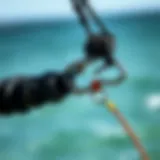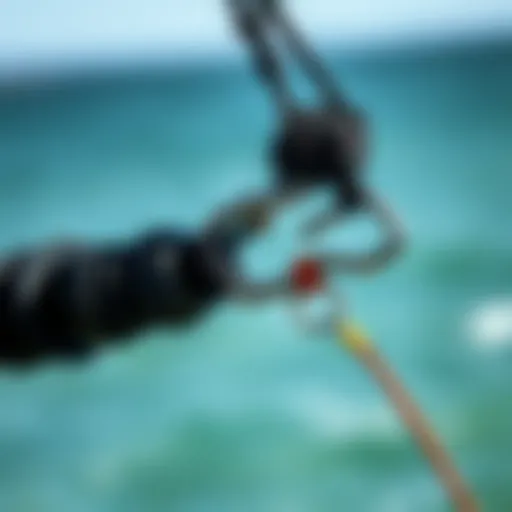Comprehensive Guide to Inflatable Wingboards


Intro
As the winds dance across the ocean waves, a revolution in kiteboarding gear emerges—one that blends innovation and versatility seamlessly. The inflatable wingboard has quickly risen from the fringes of water sports to become a staple for many. But what exactly sets this equipment apart, and how does it transform the kiteboarding experience for enthusiasts?
In this guide, we aim to unpack the world of inflatable wingboards, examining their design intricacies, performance metrics, and overall contribution to the kiteboarding community. Gone are the days of rigid boards that tether riders to a single style of riding. Today, inflatable wingboards open up a realm of possibilities, inviting adventure seekers to explore uncharted waters while maintaining an edge of safety and comfort.
With an eye on detail, we’ll explore the materials used in crafting these boards, how they impact performance and durability, and essential maintenance practices to keep them in top shape. Whether you're a seasoned professional or a newcomer yearning for your first taste of kiteboarding glory, this comprehensive guide sheds light on every aspect that defines inflatable wingboards, making sure you’re equipped with all the know-how you need.
Transitioning into the particulars of gear and techniques, the journey into inflatable wingboards is as much about personal growth within the sport as it is about the equipment. Let’s dive deeper and discover what features enhance the riding experience, the latest gear reviews, and indispensable tips for every kiteboarder.
Gear Insights
Latest Gear Reviews
When it comes to choosing the right inflatable wingboard, the options can feel overwhelming. Key aspects like stability, flexibility, size, and buoyancy come into play. Some noteworthy brands leading the market are Duotone, Naish, and Slingshot. Each offers unique features that cater to different skill levels, riding styles, and environments.
- Duotone Doc: This board stood out in testing for its lightweight construction and responsiveness. Riders found it suited for different types of riders, from beginners to experts.
- Naish S27: Ideal for those looking for speed; this model features an enhanced rocker profile, providing excellent control in higher winds.
- Slingshot Wingcraft: Known for its durable materials, this board is highly regarded for tough environments, making it a favorite among adventurous kiteboarders.
In addition to these offerings, looking out for reviews on sites like reddit.com can provide insights from fellow riders who have firsthand experience with different gear.
Essential Gear for Beginners
Starting out with inflatable wingboards doesn’t have to be daunting. Here’s a list of essential gear every novice should consider:
- Inflatable Wingboard: Obviously, you’ll need a board, ideally one that’s forgiving and stable.
- Safety Harness: A good harness enhances comfort and minimizes strain during long sessions.
- Wetsuit: Depending on your location, a wetsuit is vital for warmth and protection.
- Life Vest: Safety first; a buoyancy aid can make all the difference.
- Kite: Selecting the right kite to pair with your board can elevate your experience.
While shopping for your first set of gear, don't shy away from reaching out to local kiteboarding schools or clubs. They often have insights on what works best in your local conditions and may even offer rental services.
As you gear up for your kiteboarding adventures, remember that every ride is a learning experience. Embrace the process, and enjoy the thrill that comes with conquering the waves.
Stay tuned as we explore techniques and tips to sharpen your skills and enhance your enjoyment while using inflatable wingboards.
Prolusion to Inflatable Wingboards
Inflatable wingboards have truly taken the kiteboarding scene by storm. These devices combine innovation and convenience, making them a popular choice among kiteboarders of all levels. With their unique features, inflatable wingboards are designed to enhance the overall experience on the water—whether you're a beginner learning the ropes or an expert looking for that adrenaline rush.
Definition and Purpose
To put it simply, an inflatable wingboard is a kind of board that allows riders to glide over the water's surface with the help of a wing or sail that captures the wind. The primary purpose of these boards is to provide a blend of stability, control, and maneuverability. Unlike traditional boards that might feel cumbersome, inflatable wingboards offer a lightweight and compact alternative, making them easier to transport.
Moreover, the inflation aspect means that they can be deflated, allowing for a convenient storage option. This practicality is particularly beneficial for travelers or those with limited space at home. In essence, the definition of inflatable wingboards extends beyond just being a piece of equipment; it encapsulates a lifestyle choice for many enthusiasts seeking to enjoy the water in a versatile manner.
Historical Evolution
The journey of inflatable wingboards began relatively recently when kiteboarding attracted enthusiasts searching for something more. Initially, boards were crafted from solid materials, which limited portability and accessibility. However, as the demand for more adaptable gear grew, manufacturers started exploring the inflatable concept.
Early designs focused on simple shapes and basic functionality. As technology advanced, so did the materials used in construction. Innovations in PVC and TPU, for example, started paving the way for more durable and lightweight options. By the late 2000s, inflatable wingboards began to gain traction among the kiteboarding community, providing a practical solution to the challenge of balancing performance with convenience.
As design and construction methods improved, riders noticed significant enhancements in speed and control on water. With various brands continuously pushing the envelope on design, inflatable wingboards have now become cornerstone pieces of equipment in the world of kiteboarding, embodying the spirit of progression in the sport.
Design Features of Inflatable Wingboards
When one looks at the inflatable wingboard, it’s clear that the design features play a crucial role in how effective and enjoyable the riding experience can be. Each element, from materials to construction techniques, contributes not only to performance but also to user satisfaction. In this regard, understanding the design features can make the difference between a mediocre outing and a thrilling adventure on the water.
Materials Used
PVC vs. TPU
Diving into the core materials that make up inflatable wingboards reveals a fierce debate between PVC and TPU. Each material comes with its own set of pros and cons. PVC stands out for its affordability and ease of production. It's quite tough and does well against abrasions and punctures. However, it tends to become rigid in colder temperatures, which can make it less responsive in certain conditions.
On the other hand, TPU is a stronger contender, often regarded as the material of choice for high-performance wingboards. Its flexibility, even in colder waters, means better responsiveness and control. Notably, TPU is often less environmentally damaging, making it an appealing choice for eco-conscious riders.
Despite the higher cost, many opt for TPU due to its superior characteristics which ultimately enhance the overall riding experience.
Durability Considerations


Durability is crucial when it comes to inflatable wingboards, as no rider wants to have their adventure cut short by a puncture or tear. The robust nature of a top-quality wingboard can directly correlate to how long it lasts and how much fun the user has.
When manufacturers consider durability, they often incorporate reinforced stitching and high-quality materials that withstand wear and tear from repeated use. A well-made wingboard should endure UV exposure and saltwater without deteriorating, retaining its performance attributes over time. This durability is a must-have, especially for those who pursue kiteboarding as a regular hobby.
In essence, investing in a durable inflatable wingboard can save money in the long run, reducing the need for replacements and ensuring many rides ahead.
Construction Techniques
Seam Technology
How a wingboard's seams are constructed can significantly impact its performance and lifespan. Traditionally, simple heat-welded seams were the norm, but modern manufacturing techniques now offer options like double stitching and advanced bonding methods which further enhance strength. The beauty of these technological advancements is not just in aesthetics but in the overall reliability of the board.
With more advanced seam technology, riders can enjoy peace of mind knowing that their gear is less likely to fail during crucial moments out on the water. While heat-welded seams are effective, those employing double stitching add an extra layer of safety that provides further assurance against leaks and ruptures.
Weight Distribution
Another critical aspect of wingboard design is how weight is distributed throughout the board. An evenly distributed weight guarantees stability, allowing riders to maintain control in various conditions. Poor weight distribution can lead to an unpredictable ride and may even cause a loss of balance during critical maneuvers.
Designers often leverage advanced computer modeling to optimize weight distribution, ensuring that these boards perform well whether cutting through waves or catching the breeze. Proper weight distribution not only enhances the performance but also reduces the fatigue experienced during long sessions, making it an important feature for enthusiasts of all levels.
"The right balance in weight distribution is what turns a good ride into a great one, allowing riders to enjoy the thrill without the constant worry of tipping over."
In summary, the design features of inflatable wingboards combine material choices and construction techniques that affect everything from durability to user experience. Understanding these elements empowers kiteboarders, instructors, and adventurers to make informed choices about their equipment, ultimately enhancing their time on the water.
Advantages of Using Inflatable Wingboards
Inflatable wingboards have gained notable attraction among enthusiasts, standing out in the expansive kiteboarding industry. Their charm lies in practicality and performance, making them a sought-after tool for a diverse group of riders. Understanding the advantages can shed light on why they’re becoming a popular choice for both beginners and seasoned kiteboarders.
Portability and Storage
One of the standout features of inflatable wingboards is their portability. Unlike their rigid counterparts, inflatable options can be deflated and rolled up neatly for easy transport. Imagine packing for a kiteboarding trip; you can fit an inflatable wingboard into a regular backpack or travel bag.
- Lightweight Design: These boards often weigh significantly less than traditional boards. This makes them a breeze to carry around.
- Space-Saving: When it comes to storage, inflatable wingboards require much less room. You can stow them away in a closet or even inside a car trunk without fuss.
- Travel-Friendly: For those adventurous spirits who like to travel by plane or go on road trips, the option to pack a wingboard within carry-on luggage simplifies the logistics, sparing you the hassle of rentals.
Stability and Control
While portability is a great advantage, there’s more beneath the surface. Stability and control, two vital aspects that greatly influence your riding experience, are significantly enhanced with inflatables. Whether you’re zooming through choppy waters or gliding on glass-like surfaces, these boards deliver.
- Wider Surface Area: Inflatable wingboards typically have a broader base, which translates to improved stability. This is particularly essential when riding in unpredictable maritime conditions.
- Balanced Center of Gravity: Many inflatable designs allow for a balanced distribution of weight, which aids in maintaining control during maneuvers. Understanding your board and the water can make all the difference on your ride.
- User-Friendly: For beginners, inflatable wingboards often offer more forgiving handling. The stable nature helps new riders build confidence without the fear of toppling over too easily.
"Inflatable wingboards allow riders, regardless of skill level, to experience a smoother, more controlled ride, enhancing both enjoyment and performance."
Performance Aspects
When it comes to inflatable wingboards, performance aspects play a critical role in ensuring that riders have a fulfilling experience on the water. Whether you’re an adrenaline junkie or a more relaxed rider, understanding these aspects can enhance your kiteboarding sessions significantly. The ability to glide with ease, make sharp turns, and handle varying wind conditions can make all the difference between a delightful day out and a frustrating one.
Speed and Maneuverability
Speed and maneuverability are two keystones of an enjoyable kiteboarding experience. An inflatable wingboard that allows quick acceleration and agile handling can make every ride feel exhilarating. Wingboards designed with a sleek profile cut through the water effortlessly, allowing riders to achieve impressive speeds. The lightweight construction of these boards often optimizes their agility, making sharp turns and sudden stops a breeze.
Wind Handling
Wind handling is another vital performance aspect, deserving careful consideration when selecting an inflatable wingboard. A board that reacts well to changes in wind speed and direction can greatly enhance control and stability, allowing the rider to resourcefully adjust their course as needed.
Optimal Wind Conditions
Optimizing performance in the right wind conditions is essential and can dramatically influence how your inflatable wingboard reacts. Generally, wingboards excel in moderate wind conditions—this sweet spot generally falls between 10 to 20 knots. Within these parameters, riders can glide smoothly without the risk of being overpowered or underwhelmed by the wind's strength. What makes this range desirable?
- Efficient Lift: Boards efficiently produce lift, allowing them to rise above the water for a thrilling ride.
- Stability: Moderate winds grant riders enough stability while still offering the exhilaration of harnessing the wind.
- Control: Riders can easily maneuver and execute tricks without feeling overwhelmed, making it a popular choice for both fresh riders and seasoned pros.
However, in lighter winds, riders may find that inflatable boards can be sluggish, limiting their overall experience. Conversely, in heavy winds, one might encounter difficulty in control, risking falls or crashes.
Adjustments for Different Environments
Adjusting your riding technique based on different environments is crucial for maximizing the benefits of inflatable wingboards. Environmental factors such as water conditions, terrain, and weather influence the riding experience significantly.


- Choppy Waters: In conditions where water is rough, a rider might need to lean back more to maintain balance, as the board becomes more buoyant. This helps absorb the shock from waves.
- Calm Waters: On completely flat surfaces, those looking to maximize speed can adopt a more forward-leaning posture. This adjustment reduces drag and allows the board to glide over the surface.
Riders proficient in modifying their approach based on these aspects can reap the rewards of enhanced performance in varied riding situations. This flexibility often results in a more enjoyable overall experience, catering to individual preferences and local conditions.
Maintenance and Care
Maintenance and care are imperative elements in ensuring the longevity and performance of inflatable wingboards. Just like any other piece of sporting equipment, these boards require a certain level of attention to maintain their optimal working condition. This section will cover the critical aspects of inflation and deflation procedures, along with cleaning and storage tips.
Inflation and Deflation Procedures
Proper inflation and deflation of inflatable wingboards is crucial for safety and performance. It's not just about pumping air into it and calling it a day; there's a method to it. First off, make sure to use a reliable pump specifically designed for inflatable boards. Most boards come with their own, and it's best to stick to the manufacturer's recommendations.
When inflating the board, start by laying it flat, ensuring that the valves are easily accessible. As you inflate, keep an eye on the pressure. A common mistake is overinflating, which can compromise the board’s structure and lead to daueration fractures. Generally, the optimal pressure for most inflatable wingboards ranges between 10 to 15 psi; however, refer to your individual board’s specifications for precise guidance.
Once inflated, it’s wise to check for any leaks—one way to test is by spraying a mixture of soapy water on the seams and valves. If bubbles form, that’s a flag that you might need to address those specific areas. After your session, you should deflate the board smoothly. Open the valves and fold the board from one end to prevent any unnecessary damage. If it’s windy, find a sheltered spot; you don’t want your board getting whisked away.
Cleaning and Storage Tips
After a day on the water, cleaning your inflatable wingboard is essential. Saltwater and sand can quickly become your board's worst enemies. Rinse the board with freshwater to remove any residues. It’s advisable to use a mild soap if there are any persistent stains. Scrub gently using a soft brush or cloth. Avoid harsh chemicals that could degrade the material.
For storage, once the board is clean and completely dry, deflate it to reduce its bulk. Roll it up tightly but not too tightly, as you want to avoid stressing the seams. Storing it in a cool, dry place away from direct sunlight will prevent any unexpected wear and tear. It might be tempting to toss it in the corner of your garage, but taking the time to stow it properly can extend its lifespan significantly.
"Taking care of your inflatable wingboard is not just a task; it’s an investment in countless days of kiteboarding enjoyment."
Safety Considerations
Safety plays a pivotal role in any sport, and kiteboarding is no exception. As exciting as the experience of wielding an inflatable wingboard can be, it’s essential to approach it with a prudent mindset. Understanding the safety considerations not only helps prevent accidents but also enhances overall enjoyment on the water.
Being aware of your surroundings, equipment status, and water conditions can make a world of difference. The inherent dynamics of kiteboarding—like the elements involved—can change rapidly, and having solid safety protocols is vital. Here, we explore two key areas: the importance of pre-use inspections and having emergency procedures in place.
Pre-Use Inspections
Before hopping onto your inflatable wingboard, conducting a thorough pre-use inspection should be non-negotiable. Like checking the brakes before driving a car, ensuring every component of your wingboard is functioning correctly is crucial.
- Visual Check: Look over the entire board for any visible signs of damage such as tears or punctures. Don’t forget to look at the seams; they are often where issues arise.
- Inflation Integrity: Ensure the inflation valve is secure and that the board is properly inflated. Under-inflated boards handle poorly and can increase the risk of accidents.
- Leashes and Safety Gear: Ensure your leash is in good condition and that any safety gear, like helmets or impact vests, are correctly fitted and free from defects.
- Environmental Awareness: Assess wind conditions, water currents, and potential hazards in your area. The last thing you want is to be caught off guard by changing conditions.
Doing this not only keeps you safe, but also boosts your confidence while riding.
Emergency Procedures
Despite the best safety measures, emergencies can happen. Having a plan in place can turn a potential disaster into a manageable situation.
- Know How to Signal: Understand and practice hand signals with fellow kiteboarders or spotters on shore. It can be hard to communicate over the noise of the wind and water, and clear signals can save time during emergencies.
- Understanding Downwind Drift: If you find yourself in trouble, knowing how to navigate your way back to shore becomes critical. Familiarize yourself with how to handle downwind drift, as the wind can often push you away from safety quickly.
- Self-Rescue Techniques: Make sure you are trained in self-rescue techniques. This includes how to secure your board to yourself and using it as flotation if needed.
- Safety Devices: Carry a whistle or signaling device. In the event of a complete loss of control, these devices can attract attention from others in the area.
"Safety is not a gadget but a state of mind."
— Eleanor Everet
Being prepared will allow you to enjoy your time on the water with peace of mind. By carrying out pre-use inspections and having emergency procedures, you’re not just protecting yourself; you’re boosting the safety of everyone around you, which is the hallmark of a responsible kiteboarder.
Comparative Analysis
In the realm of kiteboarding, the choice of equipment can have a profound impact on the overall experience. This section sheds light on the comparative analysis between inflatable wingboards and traditional wingboards, crucial for enthusiasts looking to maximize their adventures on water.
Inflatable vs. Traditional Wingboards
Understanding the distinctions between inflatable and traditional wingboards is essential for making informed decisions. Inflatable wingboards have surged in popularity, primarily due to their convenient storage and transport options. Unlike traditional wingboards, which are typically rigid, inflatable models pack down small, fitting into a backpack or trunk with relative ease.
A few key differences include:
- Weight: Inflatable wingboards often weigh less than their rigid counterparts, facilitating easier handling.
- Flexibility: They offer a unique flex that can absorb choppy seas better, providing a smoother ride on less-than-ideal days.
- Durability: The use of high-quality materials, like TPU, can make inflatable boards surprisingly resilient. However, traditional boards, while robust, can chip or dent more readily when faced with rocky shores.
On the other hand, traditional wingboards are praised for their immediate responsiveness to rider inputs. Many kiteboarders feel they provide better feedback, helping with advanced maneuvers. This performance advantage, however, may come at the cost of convenience compared to inflatable variants.
User Preferences
Ultimately, user preferences play a pivotal role in the comparative analysis of inflatable and traditional wingboards. Each rider's experience and comfort with different styles of equipment will dictate their choice of board. While seasoned professionals often lean towards traditional boards for speed and precision, recreational riders, especially beginners, may appreciate the user-friendliness of inflatable boards.


Factors Influencing Choices:
- Skill Level: Novices benefit from the stability of inflatable boards, while experts may seek the high performance of traditional units.
- Travel Frequency: Riders who frequently travel to kiteboarding destinations find inflatable boards advantageous, as they are easy to transport.
- Water Conditions: Depending on the location's wind and wave patterns, a rider’s choice may tilt towards one type over the other.
"The passion and personal connection to one's equipment can sway preferences in ways that specs alone cannot."
In summarizing the comparison, no single type reigns supreme; rather, it all boils down to the rider’s individual preferences and circumstances. This knowledge allows kiteboarding enthusiasts to choose equipment that not only fits their style but enhances their kiteboarding adventures.
Community and Culture
The intersection of community and culture within the realm of inflatable wingboards embodies more than just a recreational activity; it's about creating a vibrant ecosystem that sees individuals not only mastering a sport but also developing intricate bonds with fellow enthusiasts. The culture surrounding kiteboarding, especially with the rise of inflatable wingboards, influences everything from the shared experiences at beaches to organized events promoting this exhilarating pastime.
Kiteboarding Events Featuring Inflatable Wingboards
Kiteboarding events that showcase inflatable wingboards are increasingly becoming a central hub for enthusiasts to gather, learn, and exchange ideas. They provide an opportunity to see cutting-edge designs, witness professional athletes in action, and connect with the community.
- Events such as the Kiteboarding World Championship often feature inflatable wingboards as part of their lineup, generating excitement within the kiteboarding community.
- Regional contests, like the Hells Gates Challenge and local meetups at popular spots like Cape Hatteras, encourage amateur riders to compete and showcase their skills.
These events typically include workshops discussing techniques, gear maintenance, and tips for improving performance on the water. More than competitions, they represent a chance for participants to learn from each other.
User Experiences and Testimonials
The voices of kiteboarders provide a testament to the joys and challenges tied to inflatable wingboards. Many riders share their stories through online forums and social media, creating an extensive network of experiences that can be invaluable for newcomers. Here’s a glimpse:
- Flexibility and Convenience: "I love how I can easily pack my wingboard in the trunk. It fits just right, and once I inflate it, I'm ready for a day of fun on the water!"
- Community Support: "Every time I'm at the beach, there are always fellow kiteboarders willing to share their tricks. The community vibe is so encouraging!"
This shared journey builds a sense of belonging that transcends geographical boundaries. Whether someone is a novice or a seasoned pro, the stories, tips, and community support come together, creating a rich tapestry of experiences that define inflatable wingboarding today.
"Kiteboarding is not just a sport; it’s a way of life for many. The connections fostered through shared insights and experiences enrich our adventures on the water."
Through these testimonials, the significance of community becomes clear. The social fabric woven through collective passion is a vital part of the inflatable wingboard experience, transforming solitary adventures into community celebrations.
By exploring kiteboarding events and listening to the voices within the community, one can truly appreciate how inflatable wingboards are more than mere equipment; they are gateways to a culture defined by shared experiences and connections.
Future of Inflatable Wingboards
The future of inflatable wingboards holds significant promise for kiteboarding enthusiasts and the entire industry. With advances in technology and evolving market trends, these boards are not only enhancing user experience but also pushing the boundaries of performance. Understanding where inflatable wingboards may go next helps riders, manufacturers, and instructors stay ahead of the curve. Consideration of technological advances and market dynamics is crucial for anyone invested in this exciting sport.
Technological Advancements
As we step forward into a new era of kiteboarding gear, it’s important to recognize the role of technology in shaping the inflatable wingboard landscape. From materials that enhance performance to design innovations, the technological advancements in this field play a pivotal role in increasing the appeal and functionality of these boards.
- Material Innovations: The shift from traditional materials to composite blends significantly impacts performance. Innovators are experimenting with lighter yet stronger materials that promise greater durability and maneuverability. For instance, replaceable hybrid fabric combines properties of both PVC and TPU, retaining flexibility while reducing weight.
- Inflation Systems: Enhanced inflation systems are making setup quicker and easier. New pump designs with integrated pressure gauges ensure optimal inflation with less effort. This feature is particularly invaluable for beginners, who may struggle with standard pumps.
- Smart Technology Integration: Look out for boards equipped with GPS tracking and performance monitoring. Using mobile apps, users can analyze speed, distance covered, and even environmental conditions. Such features not only cater to performance enthusiasts but also enhance safety via real-time location tracking.
- Eco-friendly Materials: As sustainability becomes a priority, manufacturers are beginning to leverage recyclable materials and environmentally friendly production methods. This trend not only appeals to eco-conscious consumers but also helps in minimizing waste in production lines and during the board's lifecycle.
"With the right tools and mindset, anyone can ride the wind and waves. The technology behind inflatable wingboards is paving the way for a seamlessly exhilarating experience."
Market Trends
The trajectory of inflatable wingboards is influenced not just by technological improvements but also by prevailing market trends. As the community of kiteboarding grows, the demand for versatile and easy-to-use gear rises:
- Growing Popularity of Water Sports: Participation in water sports continues to surge, thanks to rising awareness and accessibility. Inflatable wingboards are becoming a gateway for newcomers, allowing them to easily enter the world of kiteboarding. This trend signals a promising market for manufacturers and retailers alike.
- Customization Options: More riders desire boards that suit their individual style and performance needs. Companies are responding by offering customizable designs, colors, and specifications that enhance user satisfaction and loyalty. This diversification is reshaping customer engagement strategies and contributing to brand strength within the industry.
- Online Community and Influence: Online platforms, from Reddit discussions to dedicated Facebook groups, are fostering lively exchanges and user feedback. With influencers contributing valuable reviews and demonstrations, social media’s role in shaping consumer choices can’t be ignored. Prospective buyers often rely on these insights when selecting gear, which is vital for manufacturers to acknowledge.
- Rental and Test Programs: As more companies offer rental and demo opportunities, enthusiasts are likely to try before buying. This trend not only lowers the barrier for entry but also enhances consumer education about the benefits associated with inflatable wingboards.
In summary, the future of inflatable wingboards is bright, driven by relentless innovation in technology and changing market dynamics. Enthusiasts can look forward to enhanced user experiences that combine style, function, and sustainability.
Closure
In wrapping up our exploration of inflatable wingboards, it's vital to reflect on the significance of understanding this innovative piece of equipment. The last section encapsulates not just the nuts and bolts of inflatable wingboards but also their broader implications in the kiteboarding world. We have delved into design intricacies, performance nuances, and community interactions, which together form a comprehensive overview.
Summarizing Key Points
To concisely revisit the various elements covered, we can highlight these key points:
- Definition & Purpose: Inflatable wingboards are designed to enhance stability and ease of use, making them appealing to both beginners and seasoned riders.
- Materials & Construction: The choice of materials like PVC and TPU is crucial for durability and performance, and the manufacturing processes impact weight and resilience.
- Advantages: Portability tops the list of benefits, allowing riders to travel with ease, while stability and control are notable during varied conditions.
- Maintenance Practices: Proper care, from inflation to cleaning, ensures longevity and consistent performance of the wingboard.
- Safety Protocols: Pre-use checks and understanding emergency procedures can significantly mitigate risks while engaging in this sport.
- Community Aspects: Events showcasing inflatable wingboards reveal a thriving culture where enthusiasts share experiences and foster connections.
- Future Prospects: Anticipating technological advancements and market trends can guide potential buyers toward making informed decisions.
Ultimately, these points coalesce to reveal the multi-dimensional nature of inflatable wingboards and their role in enhancing the kiteboarding experience.
Encouraging Further Exploration
Encouraging those interested to dive deeper into the realm of inflatable wingboards is imperative. As the market evolves, staying updated on new materials, technologies, and consumer preferences can significantly impact one’s experience on the water.
- Visit Forums: Engaging in communities on platforms such as Reddit can provide firsthand insights from users and experts alike, revealing tips and tricks that books and guides often miss out on.
- Follow Technological Trends: Websites like Wikipedia or Britannica could yield valuable information on recent innovations.
- Network with Peers: Facebook groups or local kiteboarding clubs can be treasure troves of advice, event announcements, and experience sharing.
The world of inflatable wingboards is dynamic; it’s not only about owning the equipment but also about understanding its context in kiteboarding culture. This holistic approach enhances both the knowledge and experience as one glides over the waves.















